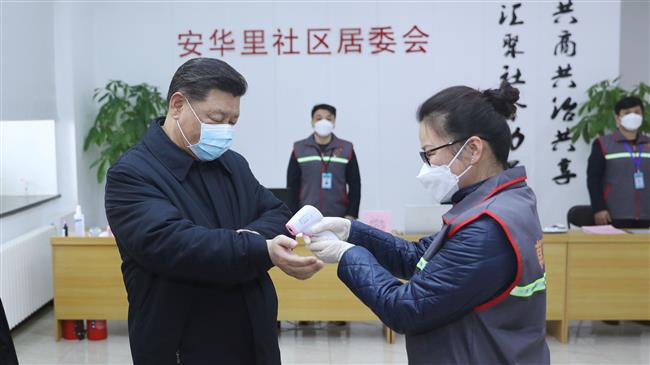
WUHAN– The situation in Wuhan, the epicenter of the novel coronavirus, is still very grave, Chinese President Xi Jinping warned during a rare visit to frontline medical staff and patients affected by the deadly coronavirus that has killed more than 1,000 people.
The Chinese president, who has called the virus a “demon”, made the rare public appearance amid the outbreak to meet frontline medical staff at Beijing Ditan hospital, where infected patients are being treated.
Xi called the situation at Wuhan, the virus epicenter, “still very grave”, and urged “more decisive measures” to contain the spread of the epidemic, said state broadcaster CCTV.
He has largely kept out of the public eye since the virus outbreak spiraled across the country from Hubei province to infect more than 40,000 people.
He appointed Premier Li Keqiang to lead a group tackling the outbreak, and it was Li who visited ground zero in Wuhan last month.
On Monday Xi put on a blue mask and white surgical gown to meet doctors at the hospital, observe the treatment of patients and speak via video link to doctors in Wuhan, state media said.
He then visited a residential community in central Beijing to “investigate and guide” efforts to contain the epidemic, said CCTV.
Video footage showed Xi having his temperature taken with an infrared thermometer, then speaking with community workers and waving at smiling residents leaning out of their apartment windows.
Death toll tops 1,000
China confirmed a rise in the number of new coronavirus cases on Monday morning, quashing hopes after several days of declining infection rates that strict control measures could be paying off. By Monday evening, the death toll topped 1,000, more than were killed during the SARS virus outbreak in 2003.
The number of confirmed infections in mainland China rose 15% Sunday to at least 40,171. More than 300 cases have been confirmed outside China, including 12 in the US, and global health officials have warned that could be just “the tip of the iceberg” as they learn more about how easily the disease spreads.
Dozens of new cases were confirmed Monday on a quarantined cruise ship in Yokohama, Japan, meanwhile, including more Americans. The number of passengers already removed or soon to be removed from the Diamond Princess for treatment in Japanese hospitals stood at 135 Monday. That includes at least 23 American passengers, 11 of whom were among the 65 new cases confirmed Monday. Most of the 3,711 passengers and crew remained under isolation orders on the ship.
The outbreak has prompted unprecedented action by the Chinese government, including locking down entire cities in Hubei as well as cutting transport links nationwide, closing tourist attractions and telling hundreds of millions of people to stay indoors.
The sweeping measures turned cities into ghost towns — but there were some signs of normality returning on Monday.
Roads in Beijing and the financial hub of Shanghai had significantly more traffic, while the southern city of Guangzhou said it would start to resume normal public transport.
What happens if you catch the new coronavirus?
The death toll from the new coronavirus in China surged past 1,000 on Tuesday, as Beijing stepped up efforts to treat tens of thousands of sick people and the World Health Organization (WHO) urged the world to “fight this virus before it gets out of control”.
Since the new type of virus was first detected in the central Chinese city of Wuhan in December, it has infected more than 43,000 people and spread to two dozen countries.
The rapid advance of the virus – known as the 2019-nCoV – has triggered fear across the globe, despite all but two of the deaths and 99 percent of the infections reported as occurring in mainland China. As the fear spread, scientists and researchers around the world have ramped up efforts to understand the new virus and how it affects the human body.
Here is what we know about the 2019-nCoV and what it does if you are infected.
‘Varying levels of severity’
The 2019-nCoV belongs to a family of viruses that can cause respiratory illnesses in humans such as the common cold and the more severe diseases such as the Severe Acute Respiratory Syndrome (SARS) and the Middle East Respiratory Syndrome (MERS).
How dangerous is the new coronavirus?
Thought to have jumped to a human from an as-yet-unidentified animal source, the new virus spreads primarily through respiratory droplets, such as those generated when an infected person coughs or sneezes. On average, it takes about five to six days for someone to show symptoms after becoming infected.
The virus multiplies in the respiratory tract and can cause a range of symptoms, according to Dr Maria Van Kerkhove, who heads the WHO’s Health Emergencies Programme.
“You have mild cases, which look like the common cold, which have some respiratory symptoms, sore throat, runny nose, fever, all the way through pneumonia. And there can be varying levels of severity of pneumonia all the way through multi-organ failure and death,” she told reporters in Geneva last week.
However, in most cases, symptoms have remained mild.
“We’ve seen some data on about 17,000 cases and overall 82 percent of those are mild, 15 percent of those are severe and 3 percent of those are classified as critical,” said Van Kerkhove.
Fever, cough, pneumonia
A study of 138 patients infected with new virus in Wuhan, published in the Journal of American Medical Association (JAMA) on February 7, showed the most common symptoms were fever, fatigue and dry cough. A third of the patients also reported muscle pain and difficulty breathing, while about 10 percent had atypical symptoms, including diarrhoea and nausea.
The patients, who ranged in age from 22 to 92, were admitted to the Zhongnan Hospital of Wuhan University from January 1-28. “The median age of patients is between 49 and 56 years,” JAMA said. “Cases in children have been rare.”
While most cases appeared to be mild, all the patients developed pneumonia, according to JAMA.
About a third subsequently developed severe breathing difficulties, requiring treatment in the intensive care unit. The critically ill were older and had other underlying conditions such as diabetes and hypertension.
Six out of the 138 patients died – a figure amounting to a 4.3 percent death rate, which is higher than estimates from other parts of China. Less than 2 percent of the total number of infected people have died from the virus so far, but that ratio could change since the outbreak is still in its early days.
Meanwhile, a study published on January 24 in The Lancet, a medical journal, found what it called a “cytokine storm” in infected patients who were severely ill. The condition is a severe immune reaction in which the body produces immune cells and proteins that can destroy other organs.
Some experts say this could explain deaths in younger patients who have died from the virus. Statistics from China show some people in their 30s, 40s and 50s who are not known to have prior medical issues have also died from the disease.
A timeline of how the disease progresses
According to JAMA, on average, people became short of breath within five days of the onset of their symptoms. Severe breathing trouble was observed in about eight days.
The study did not give a timeline for when the deaths occurred.
However, an earlier study published in the Journal of Medical Virology on January 29 said on average, people who died do so within 14 days of the onset of the disease.
The New England Journal of Medicine, in a study published on January 31, also offered a look at how the coronavirus infection affects the body over time.
The study examined medical data of a 35-year-old man, who was the first case of infection in the United States. The first symptom was a dry cough, followed by a fever.
On the third day of illness, he reported nausea and vomiting followed by diarrhoea and abdominal discomfort on the sixth day. By the ninth day, he had developed pneumonia and reported difficulty breathing.
By the twelfth day, his condition had improved and his fever was subsiding. He developed a runny nose, however. And on day 14, he was asymptomatic except for a mild cough. When the study was published, he remained hospitalised.
Follow this link to join our WhatsApp group: Join Now
Be Part of Quality Journalism |
Quality journalism takes a lot of time, money and hard work to produce and despite all the hardships we still do it. Our reporters and editors are working overtime in Kashmir and beyond to cover what you care about, break big stories, and expose injustices that can change lives. Today more people are reading Kashmir Observer than ever, but only a handful are paying while advertising revenues are falling fast. |
| ACT NOW |
| MONTHLY | Rs 100 | |
| YEARLY | Rs 1000 | |
| LIFETIME | Rs 10000 | |













